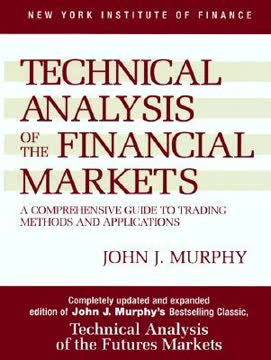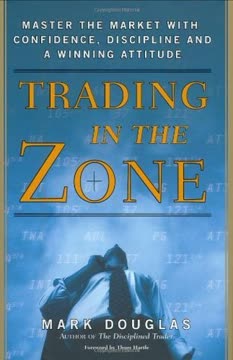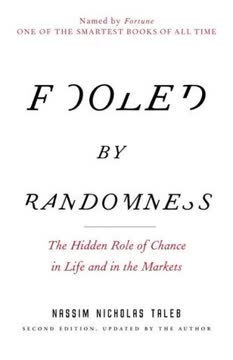Key Takeaways
1. Markets are highly random, but small edges exist for skilled traders
Every edge we have, as technical traders, comes from an imbalance of buying and selling pressure.
Markets are complex systems that often appear random, making consistent profits challenging. However, skilled traders can identify slight statistical edges by recognizing imbalances in buying and selling pressure. These edges manifest as patterns in price action and market structure.
Key concepts for finding edges:
- Focus on high-probability setups or excellent reward/risk ratios
- Understand that edges are only valid over large sample sizes
- Recognize that most observed price movements are random
- Develop skills to identify less random market conditions
Challenges of trading: High-risk decisions made under pressure with insufficient information. Traders must learn to make decisions in this uncertain environment while managing their psychology and risk.
2. Price action reflects the interplay of motive and resistive forces
Price action is the term used to describe the market's movements in a dynamic state. Price action creates market structure, which is the static record of how prices moved in the past.
Understanding price action is crucial for technical traders. It represents the dynamic interplay between buying and selling pressure, which creates observable market structure. Price action can be thought of as the result of two opposing forces: a motive force attempting to move price, and a resistive force opposing that movement.
Key elements of price action:
- Impulse moves (strong directional movement)
- Consolidations and pullbacks
- Support and resistance levels
- Trend structure (higher highs/lows in uptrends, lower highs/lows in downtrends)
Traders should focus on identifying points where price action becomes less random, potentially offering tradable opportunities. This requires developing a deep understanding of how markets typically move and react to various conditions.
3. The Wyckoff market cycle provides a framework for understanding market behavior
Wyckoff proposed a four-stage market cycle. His idea was that the cycle resulted from the actions of these large players who planned their operations in the market to take advantage of the uneducated public's inappropriate reactions to price movement.
The Wyckoff cycle offers a model for understanding market behavior through four phases: accumulation, markup, distribution, and markdown. This framework helps traders identify potential opportunities and risks at different stages of market development.
Wyckoff cycle phases:
- Accumulation: Sideways range, large players quietly buy
- Markup: Uptrend, public becomes aware and participates
- Distribution: Sideways range, large players sell to public
- Markdown: Downtrend, public realizes trend has changed
Understanding this cycle can help traders align their strategies with the actions of large, informed market participants. However, it's important to recognize that real markets are often messier and less clearly defined than this idealized model suggests.
4. Technical traders must focus on four primary trade setups
Every technical trade imaginable falls into one of these categories.
Four primary trade setups form the foundation of technical trading strategies. Understanding and mastering these setups allows traders to adapt to various market conditions and opportunities.
The four trade setups:
- Trend continuation: Enter in the direction of an established trend
- Trend termination: Enter against a trend, anticipating its end
- Support/resistance holding: Trade bounces off key levels
- Support/resistance failing: Trade breakouts through key levels
Each setup has unique characteristics, probabilities, and risk/reward profiles. Successful traders often specialize in one or two setups that align with their personality and risk tolerance, but understanding all four provides a comprehensive toolkit for navigating different market environments.
5. Moving averages and indicators can provide valuable context when properly understood
There is no magic in intuition. Rather, it is a normal problem solving skill that functions on a level outside of consciousness.
Technical indicators like moving averages and the MACD can offer valuable insights when used correctly. However, it's crucial to understand their construction, limitations, and how they react to different market conditions.
Key points for using indicators effectively:
- Understand the mathematical construction of each indicator
- Recognize how indicators respond to various price patterns
- Use indicators to confirm or provide context, not as primary decision-makers
- Avoid overcomplicating charts with too many indicators
Indicators should be viewed as tools to highlight and emphasize important elements of market structure, not as magical predictors of future price movement. Developing a deep understanding of a few carefully chosen indicators is often more valuable than using many indicators superficially.
6. Psychological biases and emotions significantly impact trading performance
The market is essentially designed to cause traders to do the wrong thing at the wrong time. It is not so much that the market is against us; it is that the market sets us against ourselves.
Psychological challenges are a significant hurdle for many traders. The market environment often exacerbates cognitive biases and emotional reactions, leading to poor decision-making.
Common psychological pitfalls:
- Overconfidence bias
- Confirmation bias
- Gambler's fallacy
- Loss aversion
- Illusion of control
Successful traders develop strategies to manage their emotions and counteract these biases. This may involve strict risk management rules, pre-defined trading plans, and regular self-reflection. Recognizing that these biases exist and actively working to mitigate their impact is crucial for long-term trading success.
7. Developing intuition and achieving flow state are crucial for high-level trading
Intuition is real, but it is not special. Everyone who has interactions with the market quickly develops some degree of intuition, so the presence of intuition is not a trading edge.
Cultivating intuition is an important aspect of becoming a skilled trader. However, intuition must be based on a foundation of correct principles and extensive experience. Flow state, characterized by complete absorption in the task and effortless performance, is often associated with peak trading performance.
Developing trading intuition:
- Gain repeated exposure to consistently structured market data
- Approach the work with an open, receptive attitude
- Balance intuition with rational analysis and risk management
- Recognize that intuition can be fallible and requires ongoing refinement
Achieving flow in trading requires clear objectives, immediate feedback, and confidence in one's skills. Creating an environment conducive to flow can significantly enhance trading performance and decision-making.
8. Consistency and proper risk management are essential for long-term success
Good trading is, to a large degree, boring and predictable.
Consistency in approach is crucial for long-term trading success. This applies to trade execution, risk management, record-keeping, and analysis of results. Successful traders often develop routines and processes that they follow rigorously.
Key elements of consistent trading:
- Clearly defined trading rules and risk parameters
- Regular review and analysis of trading results
- Continuous learning and refinement of skills
- Emotional discipline and adherence to the trading plan
Proper risk management is fundamental to survival in the markets. This includes setting appropriate position sizes, using stop-losses, and managing overall portfolio risk. Traders must remember that preservation of capital is crucial, as it allows them to continue trading and capitalize on future opportunities.
Last updated:
FAQ
What's "The Art and Science of Technical Analysis" about?
- Comprehensive Guide: The book by Adam H. Grimes is a comprehensive guide to understanding market structure, price action, and trading strategies.
- Focus on Technical Analysis: It emphasizes the importance of technical analysis in trading, providing insights into how price movements can be analyzed to predict future market behavior.
- Practical Approach: The book offers a practical approach to trading, combining theoretical knowledge with actionable strategies for traders at all levels.
- Market Psychology: It also delves into the psychological aspects of trading, helping traders understand their own biases and improve their decision-making processes.
Why should I read "The Art and Science of Technical Analysis"?
- Develop a Trading Edge: The book helps traders find and develop a trading edge, which is crucial for long-term success in the markets.
- Understand Market Cycles: It provides a detailed explanation of market cycles, helping traders identify different phases and adapt their strategies accordingly.
- Improve Risk Management: Readers will learn about effective risk management techniques, which are essential for protecting capital and maximizing returns.
- Enhance Psychological Skills: The book addresses the psychological challenges of trading, offering strategies to manage emotions and improve trading discipline.
What are the key takeaways of "The Art and Science of Technical Analysis"?
- Trading Edge: A trading edge is essential for success, and traders must identify moments when markets are less random to capitalize on opportunities.
- Market Structure: Understanding market structure and price action is crucial for identifying trading opportunities and managing risk.
- Psychological Mastery: Traders must master their emotions and cognitive biases to make rational decisions and avoid common pitfalls.
- Continuous Learning: Trading is an ongoing process of learning and adaptation, requiring traders to constantly refine their strategies and skills.
What are the best quotes from "The Art and Science of Technical Analysis" and what do they mean?
- "Trading is hard." This quote emphasizes the competitive and challenging nature of trading, highlighting the need for a verifiable edge and disciplined approach.
- "Markets are extremely competitive." It underscores the importance of understanding market dynamics and being prepared to adapt to changing conditions.
- "You must have an edge." This quote stresses the necessity of having a statistical advantage in trading to achieve consistent profits.
- "Trading is not about being right or predicting the future." It highlights the importance of focusing on probabilities and managing risk rather than trying to predict market movements.
How does Adam H. Grimes define a trading edge in "The Art and Science of Technical Analysis"?
- Positive Expectancy: A trading edge is defined as having a positive expectancy, where the sum of profits from winning trades exceeds the sum of losses from losing trades over time.
- Statistical Advantage: It involves identifying moments when markets are less random and placing trades aligned with slight statistical edges.
- Avoid Random Markets: Traders should avoid market environments that are highly random, as consistent profits are not possible in such conditions.
- Develop and Refine: Developing and refining a trading edge is an ongoing process that requires continuous monitoring and adaptation.
What is the Wyckoff market cycle as explained in "The Art and Science of Technical Analysis"?
- Four Phases: The Wyckoff market cycle consists of four phases: accumulation, markup, distribution, and markdown.
- Accumulation Phase: Large players buy without moving the market, creating a base for future uptrends.
- Markup Phase: The market trends upward as the public becomes aware of the price movement, often driven by smart money.
- Distribution and Markdown: In distribution, smart money sells to the public, leading to a downtrend or markdown as the market corrects.
How does "The Art and Science of Technical Analysis" address the psychological challenges of trading?
- Cognitive Biases: The book discusses common cognitive biases, such as overconfidence and confirmation bias, that can affect trading decisions.
- Emotional Control: It emphasizes the importance of managing emotions like fear and greed to maintain discipline and make rational decisions.
- Intuition and Flow: The book explores the role of intuition and the flow state in trading, helping traders harness these elements for better performance.
- Practical Strategies: Practical strategies are provided to help traders develop the right mindset and overcome psychological barriers.
What are the four technical trades outlined in "The Art and Science of Technical Analysis"?
- Trend Continuation: Trades that align with the current trend, often involving pullbacks or breakouts in the trend direction.
- Trend Termination: Trades that anticipate the end of a trend, focusing on potential reversals or transitions to trading ranges.
- Support/Resistance Holding: Trades that capitalize on price holding at key support or resistance levels, often involving failed breakouts.
- Support/Resistance Breaking: Breakout trades that occur when price moves beyond established support or resistance, signaling potential new trends.
How does "The Art and Science of Technical Analysis" suggest managing risk in trading?
- Position Sizing: The book emphasizes the importance of proper position sizing to manage risk and protect capital.
- Volatility-Based Stops: It recommends using volatility-based stops to account for market fluctuations and avoid premature exits.
- Chandelier Stops: The use of chandelier stops is suggested to lock in profits as trades move in the desired direction.
- Risk/Reward Ratios: Traders are encouraged to focus on trades with favorable risk/reward ratios to maximize potential returns.
What role do indicators play in "The Art and Science of Technical Analysis"?
- Supplementary Tools: Indicators are used as supplementary tools to highlight important elements of market structure and price action.
- Understanding Required: Traders must understand the indicators they use, including how they react to different market conditions.
- Consistency: Consistent use of indicators is important for developing intuition and recognizing patterns in market data.
- Confirmation: Indicators can provide confirmation for trade setups, helping traders make more informed decisions.
How does "The Art and Science of Technical Analysis" approach the concept of market structure?
- Pivot Points: Market structure is defined by pivot highs and lows, which are key elements in understanding price movements.
- Swing Analysis: The book emphasizes the importance of analyzing the length and character of swings to gauge market strength.
- Contextual Patterns: It highlights the need to consider chart patterns in context, as their predictive power depends on the surrounding market environment.
- Dynamic Process: Market structure is a dynamic process that evolves over time, requiring traders to adapt their strategies accordingly.
What is the significance of the "Trader's Mind" section in "The Art and Science of Technical Analysis"?
- Psychological Challenges: This section addresses the unique psychological challenges traders face, such as high-risk decisions and insufficient information.
- Evolutionary Adaptations: It explores how evolutionary adaptations, like pattern recognition and heuristics, can both help and hinder trading.
- Emotional Mastery: The book provides strategies for mastering emotions and cognitive biases to improve trading performance.
- Intuition and Flow: It discusses the development of intuition and the flow state, which are essential for achieving top-level trading performance.
Review Summary
The Art and Science of Technical Analysis is highly praised for its comprehensive approach to trading. Readers appreciate its in-depth exploration of market dynamics, price action, and trading psychology. The book's pragmatic and scientific approach, along with numerous examples, helps traders understand complex concepts and improve their strategies. Many consider it essential reading for technical traders, particularly swing traders. While some find it dense, most agree it's worth the effort. Reviewers consistently highlight its value in developing a deeper understanding of technical analysis and market structure.
Similar Books










Download PDF
Download EPUB
.epub digital book format is ideal for reading ebooks on phones, tablets, and e-readers.




